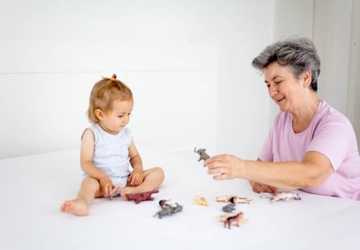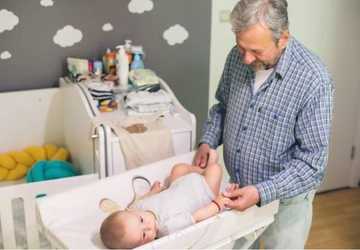The advent of a grandchild heralds a joyous epoch that necessitates meticulous preparations to safeguard their well-being. This treatise elucidates the vital precautions grandparents must implement to fortify their residences, thus crafting a sanctuary for their diminutive explorers.
Essentials of Infant Safety at the Grandparental Dwelling
Ensuring baby safety at your grandparents' house demands a scrupulous survey of your habitat from the vantage point of a curious child. Here are the fundamental measures to undertake:

Stabilize Voluminous Furniture and Apparatus
- Secure towering and substantial pieces such as bookshelves, entertainment centres, and storage cabinets to walls to preclude toppling.
- Verify the stability of all domestic machines to prevent potential hazards from accidental displacement.
Limit Accessibility to Perilous Zones
- Erect barriers at the terminus of staircases to deter ingress.
- Fortify cabinets and repositories with locks to restrict access to toxic substances and breakable commodities.
- Shield juveniles from electrical perils by insulating outlets.
Construct Enclosed Play Areas
- Allocate designated locales for play that are removed from areas of frequent movement.
- Affix cushioning to acuminated corners of furnishings to mitigate injury risks.
- Ascertain that diminutive objects susceptible to causing asphyxiation are securely stowed beyond reach.
Elaborate Approaches: How Grandparents Can Baby-Proof
How grandparents can baby-proof their habitats effectively pivots on the necessities pertinent to the grandchild's age and kinetic capacity. Here are stratagems tailored to distinct developmental phases:
For Infants
- Ascertain a secure slumber area with a rigid mattress free from loose bedclothes.
- Keep ground surfaces pristine and devoid of small debris.
- Maintain vigilant oversight of infants positioned on elevated planes.
For Toddlers
- Implement knob guards on doors to restrict entry to potentially hazardous precincts.
- Position window barriers to limit window openings to a safe extent.
- Secure floor coverings with anti-slip mats to curtail the likelihood of falls.
Provisions for a Grandchild's Visit: Anticipatory Strategies
When preparing for a grandchild's visit, deliberate throughout their vacation and any necessities they might manifest. The ensuing checklist is designed to ensure comprehensive preparedness:
- Repose Configurations: Erect a crib or fashion a secure sleeping quarter distanced from fenestrations and hefty furniture.
- Nutritional Requirements: Equip suitable sustenance apparatus such as elevated seating solutions and utensils tailored for youthful users.
- Emergency Protocols: Amass a directory of essential contacts, encompassing neighbourhood pediatric practitioners and emergency response teams, and maintain it within easy reach.
Integration of Sophisticated Safety Technologies
Utilization of Advanced Sensor Technology
- Employ cutting-edge sensors that detect motion and unauthorized access, giving grandparents real-time alerts about unusual activity.
- Consider adopting intelligent surveillance systems that offer panoramic views and can differentiate between normal play and potential danger.
Advancement in Protective Mechanisms
- Incorporate superior-quality safety locks that are sophisticated and designed to be intuitively used by older adults.
- Invest in hypoallergenic and aesthetically pleasing corner cushions that provide optimal protection without compromising home aesthetics.
Pedagogical Approaches for Safety Awareness

Continuous Safety Education
- Commit to staying abreast of the evolving standards in child safety by engaging with authoritative sources and child welfare institutions.
- Explore participatory educational sessions, either virtually or in community centres, that focus on the nuances of child-proofing from a senior's perspective.
Facilitate Instructional Play
- Designate specific zones for educational activities that safely stimulate learning while emphasizing safety protocols through playful engagement.
- Implement teaching moments during the child-proofing process to cultivate awareness about safety among young grandchildren, using storytelling techniques to illustrate precautions.
Enhancement of Exterior Child Safety
Fortification of Outdoor Recreational Areas
- Ensure all playground apparatus is anchored securely and inspected for integrity, with an underlying layer of shock-absorbent material to mitigate injury risks.
- Erect barriers around aquatic features and install sophisticated alarm systems that activate upon unexpected entry into the water.
Development of a Child-Friendly Horticultural Environment
- Select flora that is safe for child interaction, removing any species known for toxicity or adverse reactions.
- Construct protective barriers around garden areas that house tools and chemicals, ensuring they remain inaccessible to children.
Systematic Safety Evaluations and Renewals
Implementation of Regular Safety Inspections
- Organize systematic assessments of living spaces to identify and mitigate potential hazards that arise as children develop and explore more actively.
- Tailor existing safety measures to suit better visiting grandchildren's changing capabilities and curiosities.
Enhancement of Emergency Preparedness
- Assemble a comprehensive first aid kit that addresses potential emergencies and is regularly updated with the latest medical supplies.
- Display emergency protocols prominently within the home, ensuring they are updated and easily understandable for quick reference during urgent situations.
Optimization of Living Spaces for Safety
Customized Child-Proof Design Modifications
- Design living spaces with custom-built, child-friendly furniture that integrates safety features such as rounded edges, low heights, and embedded cushioning.
- Opt for wall-mounted furniture and fixtures to minimize the risk of tipping, utilizing space efficiently while enhancing child safety.
Strategic Placement of Safety Instruments
- Strategically place safety alarms and emergency tools within easy reach of grandparents and older children, ensuring prompt response capabilities.
- Consider the layout of living spaces to create clear, obstruction-free pathways that accommodate quick and safe movement throughout the home.
Proactive Measures for Emergency Management
Comprehensive Emergency Drills
- Conduct regular emergency drills with grandchildren to practice safe evacuation and response strategies, making such practices familiar and less frightening.
- Use visual aids like charts and maps to teach children about emergency exits and meeting points in a way that is easy for them to understand and remember.
Advanced Medical Preparedness
- Keep a digital inventory of all medical supplies, with alerts for restocking essential items and updating emergency medical kits.
- Provide advanced first aid training for grandparents, including CPR and emergency response techniques, tailored to the needs of infants and young children.
Conclusion
Preparing for a grandchild visit necessitates exhaustive planning and meticulous attention to minutiae. By adhering to the protocols delineated in this discourse, grandparents can cultivate a secure and pleasant environment that accentuates the delights of intergenerational bonding. The preeminent importance of baby safety at the grandparents' house demands relentless diligence and commitment. By proactively orchestrating how grandparents can baby-proof their domiciles, grandparents ensure their home transforms into a bastion of safety and delight for all juvenile visitors.